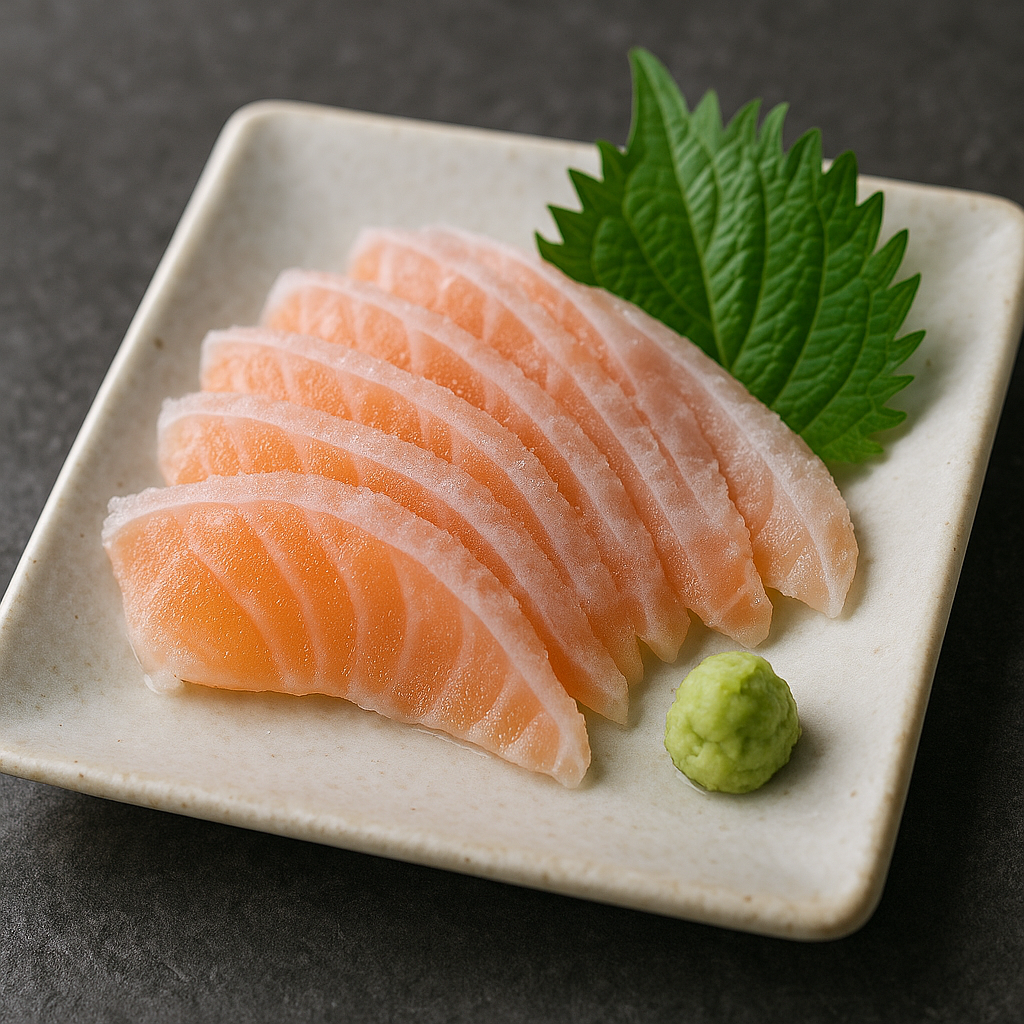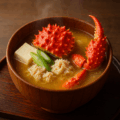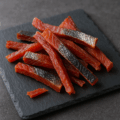ルイベの特徴
鮭を使った北海道の郷土料理
ルイベは、北海道を代表する郷土料理で、生鮭を凍らせて刺身状に切り、半解凍のまま食べる料理です。冷たい食感と鮭の旨味が楽しめるのが特徴です。
保存食としての知恵
本来はアイヌ(アイヌは日本列島北部、特に北海道に先住する先住民族であり、独自の言語、宗教、文化、そして歴史を持っています)の人々が、鮭を寒冷な気候を利用して凍結保存し、必要な時に解凍して食べていた保存食に由来します。
独特の食感と味わい
半解凍の状態で食べることで、鮭特有の脂が口の中でとろけ、冷たさと旨味が一体となった独特の食感を楽しめます。
ルイベのレシピ
材料(2〜3人分)
- 生鮭(刺身用) … 1柵
- 醤油 … 適量
- わさび … 適量
作り方
- 生鮭を水で軽く洗い、水気を拭き取る。
- 鮭をラップで包み、冷凍庫で一晩凍らせる。
- 半解凍の状態で薄切りにする。
- 醤油やわさびを添えていただく。
シェフのワンポイントアドバイス
完全に解凍してしまうと普通の刺身になってしまうため、半解凍の状態で食べるのがルイベの醍醐味です。冷凍することで寄生虫対策にもなります。
基本的には凍らせるだけですが、魚を凍らせる前に味付けする事で個性を出すことが出来ます。
ルイベの栄養価(1人分の目安)
- エネルギー:約200〜250 kcal
- たんぱく質:18〜22 g
- 脂質:10〜15 g(鮭由来の良質な脂質)
- 炭水化物:1〜2 g
- ビタミンD・B群(鮭由来)
- EPA・DHA(血流改善や脳の健康に寄与)
高たんぱくで良質な脂質を含み、低糖質のため健康的な料理です。
ルイベの歴史
アイヌの保存食
ルイベは、アイヌ民族が鮭を凍結保存していた食文化に由来します。「ルイベ」という名称もアイヌ語の「ル=溶ける」「イペ=食べ物」に由来します。
和食としての発展
保存食から発展し、現在では北海道の郷土料理として定着しました。刺身の一種として観光客にも提供され、冬の名物料理となっています。
現代のルイベ
現在では鮭だけでなく、マスや他の魚介類でもアレンジされ、冷凍技術の進歩により全国で味わえる料理となっています。
English Version
Features of Ruibe
A Traditional Hokkaido Dish Using Salmon
Ruibe is one of Hokkaido’s representative local dishes. Fresh salmon is frozen, sliced sashimi-style, and eaten while still half-frozen. The unique texture and the rich flavor of salmon can be enjoyed in this dish.
Wisdom as a Preserved Food
Originally, Ruibe was derived from the food culture of the Ainu people (the indigenous people of northern Japan, particularly Hokkaido, with their own language, religion, culture, and history). They froze salmon using the cold climate to preserve it, and thawed it when needed for consumption.
Unique Texture and Flavor
When eaten in a half-frozen state, the salmon fat melts in the mouth, blending the cold sensation with umami to create a distinctive taste experience.
Recipe
Ingredients (for 2–3 servings)
- Fresh salmon (sashimi-grade) … 1 block
- Soy sauce … to taste
- Wasabi … to taste
Instructions
- Rinse the salmon lightly in water and pat dry.
- Wrap the salmon in plastic wrap and freeze overnight.
- Slice thinly while still half-frozen.
- Serve with soy sauce and wasabi.
Chef’s Tip
Completely thawing will turn it into ordinary sashimi — the key is to enjoy it half-frozen, which is the true charm of Ruibe. Freezing also serves as a measure against parasites. For variety, you can season the fish before freezing to add originality.
Nutritional Value (per serving, approx.)
- Calories: 200–250 kcal
- Protein: 18–22 g
- Fat: 10–15 g (healthy fat from salmon)
- Carbohydrates: 1–2 g
- Vitamin D & B group (from salmon)
- EPA & DHA (contributing to blood circulation and brain health)
High in protein, rich in healthy fats, and low in carbohydrates, Ruibe is a nutritious and health-conscious dish.
Historical Background
Ainu Preserved Food
Ruibe originates from the food culture of the Ainu people, who preserved salmon by freezing it. The word “Ruibe” comes from the Ainu language: “ru” meaning “to melt” and “ipe” meaning “food.”
Development into Washoku
From preserved food, it evolved into a regional specialty of Hokkaido. Today it is served as a type of sashimi and is widely enjoyed by tourists as a winter delicacy.
Modern Ruibe
Nowadays, not only salmon but also trout and other seafood are used in Ruibe. Thanks to advances in freezing technology, it can now be enjoyed all over Japan.



何でも質問してください!